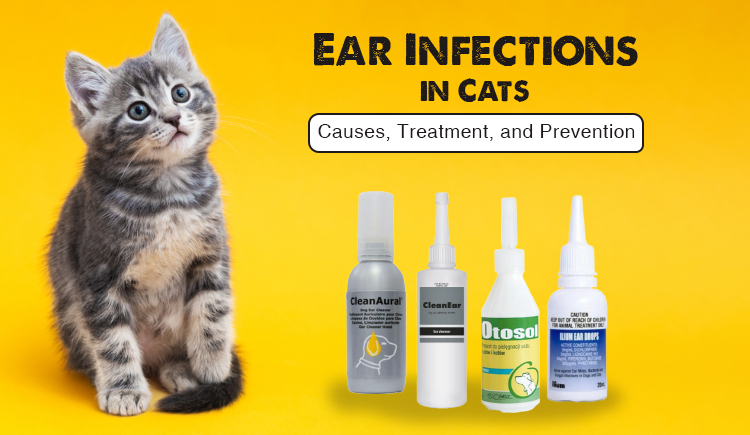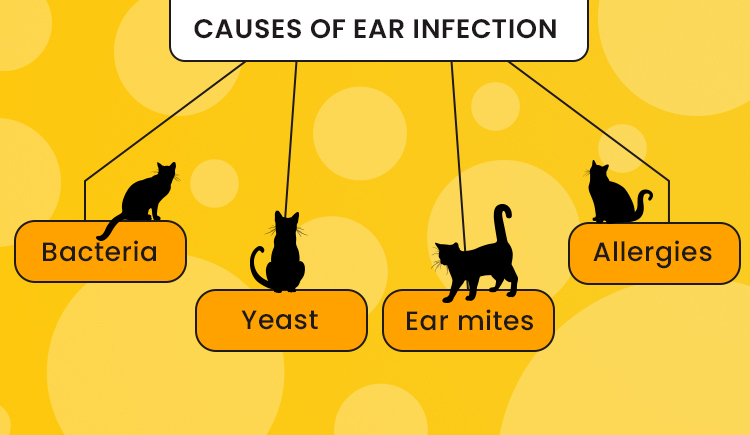
Compared to ear infections in dogs, those in cats are pretty uncommon and are generally straightforward to treat. However, they aren’t very rare either, affecting up to 20% of the population at some point in their lives. The cause of these infections can be complex. Moreover, the occurrence of these infections can be quite painful, and delayed treatment can result in permanent damage.
Causes of Ear Infections in Cats
Most of the time, the vet would diagnose that your cat has contracted ear mites. However, if that’s not the case, ear infections can indicate the sign of an underlying health condition. The felines that suffer from weak immunity, allergies, or diabetes, become more prone to ear infections. Some of the prominent underlying factors behind ear infections include:
- Bacteria: They enter the ear canal through a scratch or bite, or through the ear canal itself. Bacteria can also overgrow in the ear canal if there is too much wax or debris.
- Yeast: The cause of fungal infection, yeast overgrows in the ear canal, especially if the cat has allergies or is otherwise immunocompromised.
- Ear mites: Ear mites are another common factor that causes ear infections. These parasites live in the ear canal and irritate it, causing eventual scratching and clawing that results in ear infections.
- Allergies: Allergies to food, pollen, or other environmental allergens are another prominent reason behind inflammation and infection in the ear canal.

Apart from these, there can be some more complex, but less common causes like the presence of some other foreign body in the ear canal, autoimmune diseases, ruptured eardrums, diabetes mellitus, and tumors.
How to Detect Ear Infection in Cats
If suffering from ear infections, your feline friend will display one or more of the symptoms mentioned below:
- Head shaking
- Scratching or pawing at the ears
- Redness, swelling, or discharge from the ears
- A foul odor coming from the ears
- Loss of balance or coordination
- Tilting of the head
- Pain or discomfort when the ears are touched
Ear Infections Diagnosis in Cats
If you suspect that your kitty is suffering from an ear infection, immediately take them to the vet to get the cause diagnosed. The delay in the treatment of ear infections can lead to more complex issues. The vet would use an otoscope or take a sample of ear discharge to figure out the underlying reason behind the infection and would accordingly provide a suitable treatment.
Treatment of Ear Infections in Cats

In case of the presence of ear mites, or a yeast or bacterial infection, the vet would recommend anti-parasitics, antifungals, or antibiotics, as it might seem appropriate. These treatment options generally come in the form of an ointment or eardrops. If the infection has reached the middle ear, but the eardrum is fine, the doctor might prescribe some oral or injectable antibiotics.
After the successful treatment of ear infection, your vet will recommend using an effective ear cleaner to keep your cat’s ears free from infectious organisms. There are several efficient treatment and control options for ear infections like Clean Ear, Cleanaural Ear, Ilium Ear Drops, and Otosol that might be beneficial for your feline buddies. Gently lift the ear flap and squeeze these drop solutions into the ear canal. Then massage the base of the ear to help the formula work its way into the ear canal. Keep a check to ensure that the inside of the ear flap of your cat is pink and the canal is clear.
How to Help a Cat with an Ear Infection
Here are a few tips on how to help a cat with an ear infection:
- Give your cat their medication as prescribed by the veterinarian.
- Clean your cat’s ears regularly with a cat-safe ear cleaner.
- Be gentle when handling your cat’s ears, as they may be painful.
- Monitor your cat’s ears for signs of improvement. If the infection does not improve after a few days, please contact your veterinarian.
Prevention of Ear Infections in Cats
There are a few things you can do to help prevent ear infections in your cat:
- Clean your cat’s ears regularly with a cat-safe ear cleaner.
- Check your cat’s ears for signs of infection, such as redness, swelling, or discharge.
- Treat your cat for ear mites regularly, especially if they spend time outdoors.
- Feed your cat a high-quality diet to help support their immune system.
- If you have any concerns about your cat’s ears, please consult with your veterinarian.
Conclusion
While ear infections can be painful and irritating, they are mostly capable of being easily and effectively treated if diagnosed on time. However, a delay in treatment can result in more complex damage. So it is best that you take your feline love to the healthcare professional as soon as you notice any suspicious symptoms. Also, buy a cat ear cleaner online to ensure that the ear of the cat is clean and hygienic. This would reduce the chances of development of any ear infection.

